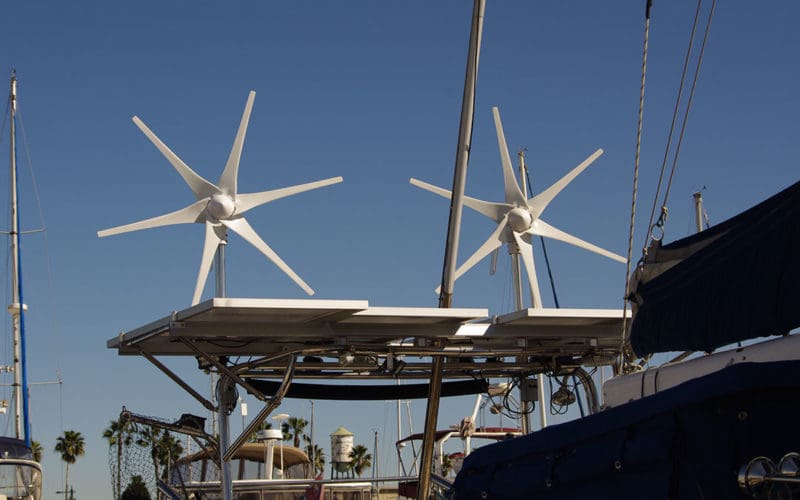Tapping into sun, wind and water power
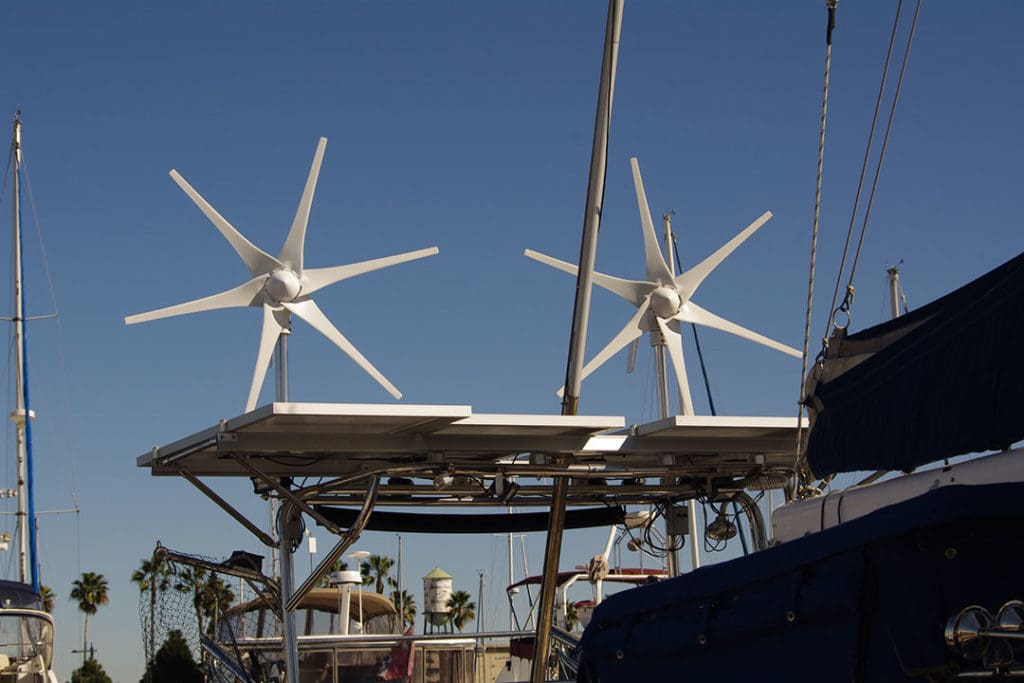
If there is one thing all cruisers have in common, it is a yearning for independence and self-sufficiency. Once we pull in the dock lines at our home marina and set out on an ocean cruise, we want to make sure we can get by with the equipment and energy sources we need to sustain ourselves on our journey.
Energy independence for today’s offshore cruising yacht entails tapping into three sources of power: sun, wind and water. With proper planning and effective energy management, these three energy sources offer 24-hour access to navigation electronics, self-steering, communication, fresh water, lighting and entertainment anywhere your sails take you.
Before attempting to design a sophisticated, multi-source charging system, your first step is to calculate how much battery power you will need. Multiply the rated amperage of each onboard device separately and then multiply that by the maximum total hours the unit is to be used during a 24-hour period.
After you add up the amp hours, you will have a fairly good idea of the charging power required on any given day, plus the amount of battery storage you will need to support your onboard systems.
Once you know your vessel’s battery amp hour needs, you can embark on designing a charging array that will take care of the needs of both vessel and crew while underway. Installing power-generating systems geared specifically to realistic needs will be a huge step toward achieving energy independence for a successful ocean crossing.
A flooded, deep-cycle 8D battery is generally rated from about 200 to 450 amp hours. You can expect a gel or AGM battery to fall somewhere between those figures. Large-capacity battery banks are usually charged individually to ensure adequate charging current, which is crucial to the health and lifespan of each battery.
A popular alternative to a huge 8D battery is a pair of 6-volt Trojan batteries connected in series to produce a two-part, 12-volt bank. This allows for easier installation where there is insufficient space for an 8D battery.
Once you have installed your battery banks, your next step is designing the charging system. Pairing your batteries with the right charging inputs will go a long way toward guaranteeing you have enough electrical power available 24/7, on any point of the globe.
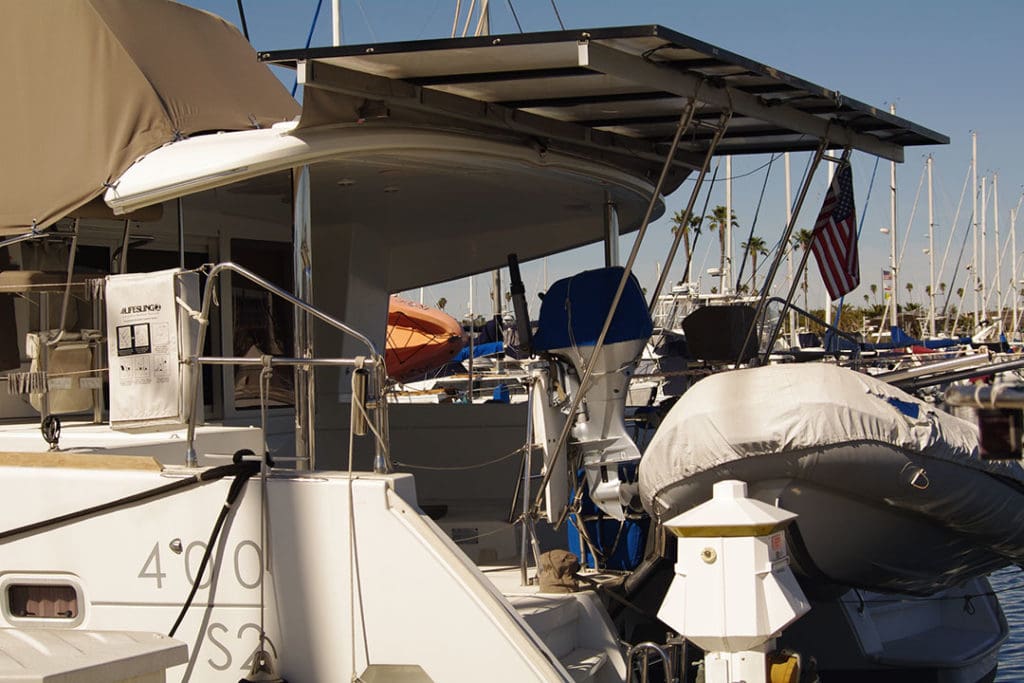
Solar power
If we were to see but one type of alternative power on a small yacht, it would be a solar panel quietly doing its job of charging the vessel’s house battery and perhaps topping off the starter battery as well. A solar panel has no moving parts, no bushings or bearings to wear out, no liquids to top off and no maintenance protocols to follow.
As long as the engine is used for charging only the starter battery now and then, a solar panel array can cover all other energy requirements for a small cruising vessel, allowing the house battery bank to support a chartplotter, a back-up GPS, VHF and SSB radios and navigation lights.
Take a walk around a hardcore cruising launch pad, such as Chula Vista Marina between San Diego and the Mexican border, and you will see all manner of alternative charging systems, particularly solar panels, mounted in more creative ways than you could imagine.
Traditional, solid glass panels sit atop equipment arches and swivel mounting poles, and amorphous, thin-film silicon cell panels, or “flexible” panels, are draped over spray dodgers, foredecks and even dinghies.
One popular item you will see is Nature Power’s Semi-Flexible 50W Monocrystalline Solar Panel, which measures 21 by 30 inches and can fit onto a variety of surfaces on a cruising yacht. Two of these panels will easily conform to the shape of a rigid spray dodger on a medium to large sailing vessel.
Other favorites from Nature Power are its two rigid solar panels, one rated at 90 watts and the other at 165 watts. At a peak of 165 watts, this large panel produces an impressive 9.43 amps, necessitating a dedicated charge controller to prevent frying the battery.
You will also see monocrystalline panels from CMPower, available as semi-flexible, semi-rigid, and rigid units of varying sizes and power ratings. Like other high-quality marine solar panels, these weather-resistant systems feature blocking and bypass diodes to prevent charge power from discharging at night and when the panel is partially or fully shaded during the day.
By the way, if you install new solar panels on your vessel before December 21, 2023, you might qualify for the Federal Solar Tax Credit. Congress currently provides a 26 percent credit for solar systems installed on homes and on boats capable of serving as homes. The credit drops to 22 percent for 2023 installations and expires in 2024 unless Congress renews it. Research the finer points of this tax credit at http://energy.gov, and install new solar panels on the quick if you want Uncle Sam to pick up a large chunk of the tab.
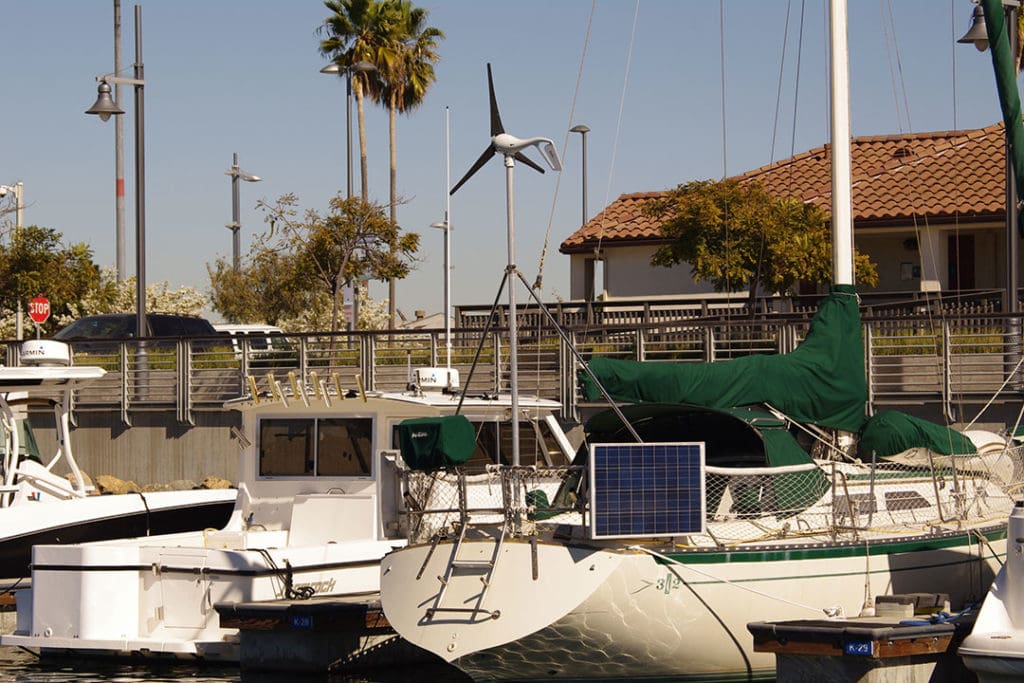
Wind power
Another power source we can bank on during our next cruise is wind. And the best place to harness that power is in an anchorage where wind can flow freely across our vessel, unimpeded by tall trees or towering cliffs.
A wind generator will also serve to some degree while underway, but on long passages, you will almost always be sailing downwind. Even while the wind blasts harder as you surf down towering seas, the residual wind velocity rarely produces adequate charging speed in the rotor.
Wherever your boat may find itself, you want a wind generator with a wide range of performance, from light zephyrs to incipient gales, to produce amperage around the clock faithfully and as quietly as possible. A wind generator is a virtual necessity, regardless of your vessel’s size, especially if you depend on a fridge to keep your food chilled.
In order to appreciate the various wind generator models available on the market, we need to understand the basic physics behind this type of apparatus. If you have ever watched a wind turbine, even a toy pinwheel in a fair breeze, you have noticed the blades rarely spin at a steady speed for more than a few seconds.
The turbine will slow down to a near-stop, and then as the wind picks up ever so slightly, the turbine becomes a blur. This is because the power produced by the wind theoretically increases as the cube of wind speed. For example, a 5-knot zephyr produces 125 units of power; at 10 knots, the power produced zooms to 1,000 units. However, according to Betz’ law, the actual power output is only 59 percent of the wind’s total power.
A key feature we look for in a marine wind generator is auto-dampening, which kicks in when the house bank is fully charged or when the wind is blowing too fast. Without this auto control, a wind turbine would fry our batteries on short order.
Sailors have a variety of high-quality wind generators from which to choose, but the one you will see most frequently is Primus Windpower’s Air X with its streamlined styling, microprocessor-controlled feathering blades, and down-turned tail, which makes the unit look like a capsized airplane. Constant design improvements in the Air X over the years, including permanent magnets with brushless electrical contacts, have significantly reduced the “whee” sound we often associate with these turbines.
The Ampair, built by Boost Energy Systems in the U.K., is in the same size and weight range as most of its competitors and generates a power curve almost identical to that of the Air X. Both units produce increasing levels of current in up to roughly 27 knots of apparent wind, after which they automatically reduce speed until the wind drops.
The three-phase Ampair 300 features a sealed, brushless alternator, a DC rectifier and blades constructed of glass-reinforced polypropylene, which is UV resistant and holds up well in all kinds of weather.
The Kiss wind generator, manufactured in Chaguaramas, Trinidad, is a high-output machine cranking out a full 4 amps in a 10-knot breeze. That comes to 96 amp hours per day, if the wind holds steady, in hardly enough wind to blow away a house fly. In 15 knots of wind, the Kiss puts out an impressive 10 amps of power, and 25 amps in 25 knots’ wind—an amp per knot—or 600 amp hours in 24 hours!
If there is one drawback to the Kiss system, it is the lack of automatic tapering blades or a self-braking rotor. When the batteries are topped off, a crew member must turn the turbine away from the wind to prevent overheating and overcharging.
As a general caveat, anytime you plan to leave your vessel at anchor for an extended period, your best bet is to brake your wind generator, turn off the fridge and leave it to the solar panels and charge controller to keep your house bank topped off.
Hydro generators
Up until the last 20 years or so, if you wanted to keep the house bank charged with water power, you would drop a bronze rotor affixed to a long piece of double-braided line over the transom and let it crank a deck-mounted generator until the battery banks were sufficiently charged.
While this was and still is a fast, effective means of producing a sizzling level of amperage over a short amount of time, it definitely had some serious drawbacks. First, it was a pain in the posterior to retrieve the line through a special device that allowed the line to continue spinning while being pulled in. Second was the tendency for that shiny, yummy turbine to attract the attention of hungry sharks. You can just imagine the dental bill for some of those unwary beasts. More often than not, you wound up having to replace the rotor.
For skippers who still prefer a towed turbine, several manufacturers continue to make them available. The Ferris Water Power 200 is a wind generator convertible to a water system while the vessel is underway. This arrangement certainly saves space and money as well, a favorable combination attractive to most of us cruisers.
By far the easiest water generator to deploy and stow when not in use is the
Watt & Sea built in Rochelle, France, and distributed in North America by Hydrovane in British Colombia.
Mounted directly to the transom, the Watt & Sea dispenses with the towline, allowing easy manual retrieval in all kinds of weather. In order to engage the device, you simply push the transom-mounted unit vertically down into the water and lock it in place. No fussing with a towline and no shark attacks.
If the Watt & Sea has one limitation, it is the device’s single purpose as a water generator instead of a combo wind-water system. And obviously, the cost of installing the Watt & Sea at just over $6,000 and a Wind X at around $1,200 is not exactly cheap. However, using the two devices in tandem does guarantee a high-quality, high-output system that will last for many years.
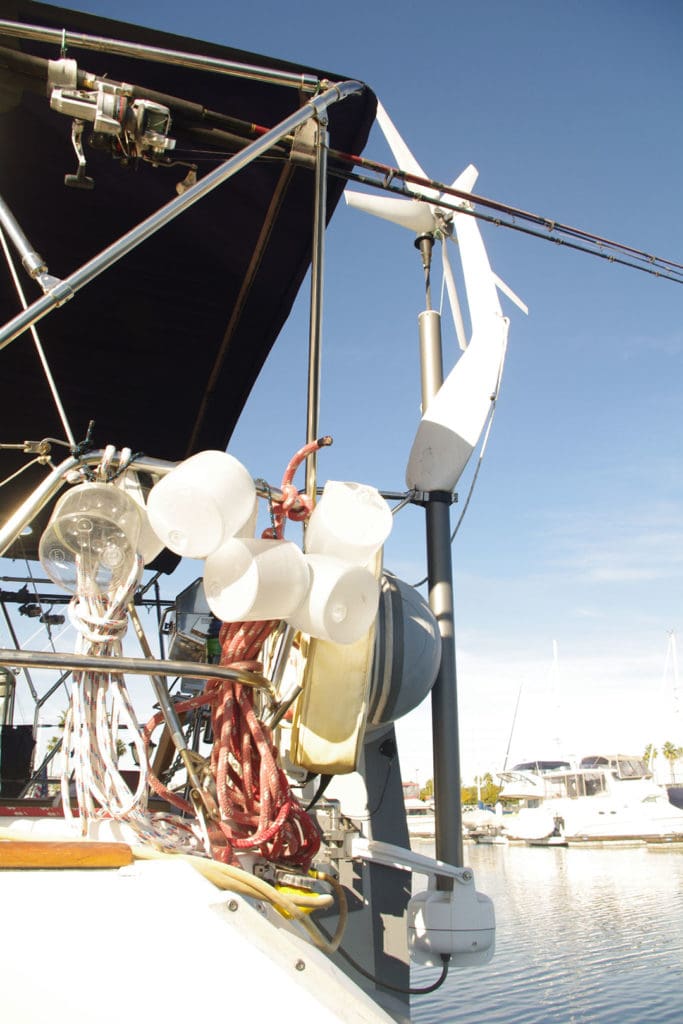
The DuoGen, offers, as the name implies, a dual air/water generator covering our charging needs both at sea and at anchor. Unlike traditional towed systems, the entire unit is self-contained and mounted permanently to the transom. The DuoGen in water mode, at a speed of five knots, generates 150 amp hours per day, and at seven knots produces up to 400 amp hours, enough power for virtually any midsized cruising vessel with refrigeration and navigation electronics running 24 hours a day.
In air mode, the DuoGen produces up to 6 amps, or 144 amp hours of current a day, in a moderate breeze of 15 knots, a sufficient amount of power for most cruising boats. And not having to house two charging units at the stern will save valuable square footage for sitting, fishing and lying out under the sun.
Cruising guru Jimmy Cornell has installed a DuoGen-3 on his aluminum-hull Garcia Exploration 45 Aventura IV, and numerous participants in Cornell’s Atlantic Relay for Cruisers (ARC) have given highly favorable reports of the system’s charging capacity in the sometimes grueling conditions of the North Atlantic.
Selecting and installing the optimum mix of electrical charging systems drawing power from both air and sea will be a physical, technical and financial challenge, regardless of the vessel or the experience and talents of the skipper. However, once your dual charging system is installed, you will have the freedom to cross oceans wherever the wind blows and the sun shines on the little blue planet. Choose wisely and enjoy your cruise! ν
Circumnavigator and author Bill Morris believes the best strategy for succeeding as an offshore voyager is to keep systems simple and, if possible, manual. Key are a windvane self-steering system, basic electronics and amenities, plus an aggressive alternative energy battery charging matrix. Bill is a frequent contributor to Ocean Navigator and the author of The Windvane Self-Steering Handbook (International Marine, 2004) and The Captain’s Guide to Alternative Energy Afloat (Seaworthy Publications, 2019).

